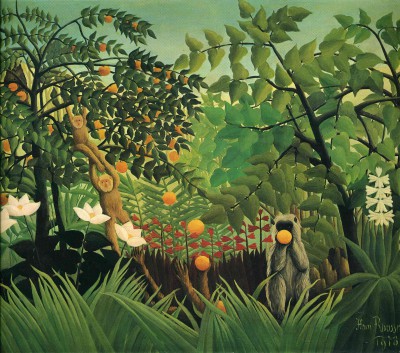The Shadow of the Avant-garde, Rousseau and Forgotten Masters / Museum Folkwang
Oct.2, 2015 – January 10, 2016
A shadow accompanies every 20th-century Avant-Garde Art Movement. Self-taught artists are what make up this shadow.*
They are painters, sculptors, and photographers with neither academic training nor access to both traditional and newly emerging channels of dissemination for their works. But their works match those by the best artists of the 20th century in artistry, aesthetic richness, immediacy, and intensity. These relative unknowns, in fact, often became an important source of inspiration for many of their famous counterparts, who gave them recognition and sometimes encouragement. The exhibition presents thirteen of these self-taught artists and a brief retrospective of their major works, which as a whole represent a kaleidoscope of widely different forms of artistic creativity.
Henri Rousseau’s jungle pictures and portraits have always been viewed in the context of the rise of modernism and have been presented, both in exhibitions and permanent collection displays, alongside works by modern masters. Not so the works of Séraphine Louis: Her disturbing flower pictures bristling with apocalyptic imagery were featured at the first documenta in 1955, but she subsequently drifted out of the public eye and is only being rediscovered now. André Bauchant’s large-scale history paintings once captured the imaginations of contemporaries like Le Corbusier and Ozenfant. Their dry, matt quality and seemingly coarse compositions are reminiscent of frescoes from the Quattrocento. Mosaic-like in texture, Morris Hirshfield’s nudes and animal portraits, meanwhile, are composed of hundreds of tiny elements and were greatly appreciated by the surrealists.
Bill Traylor, born into slavery in Alabama, began creating his lively and compositionally sophisticated paintings as an octogenarian. The exhibition is not just restricted to painting and also includes photography, in the form of Miroslav Tichý’s works. They were taken using cameras of the artist’s own construction. He later accentuated the prints by adding lines in pen or pencil and often mounted them in drawn frames. The exhibition also reacquaints visitors with the work of Adalbert Trillhaase. One of the artists associated with Johanna “Mother” Ey in 1920s Düsseldorf, he created numerous, often drastic renderings of biblical subjects. With the works of Erich Bödeker, a former miner from Recklinghausen, the exhibition presents one of the most important German self-taught artists of the post-war period. His freely modeled polychrome sculptures, mostly made of concrete, echo many aspects of his now-famous contemporaries.
The selections of these artists’ works are joined by major works of modern and contemporary art, by such artists as Honoré Daumier, Paul Gauguin, Paula Modersohn-Becker, Fernand Léger, Pablo Picasso, Blinky Palermo, and, most recently, Mike Kelley. This presentation strategy aims to reveal new dimensions in how we view these works that have substantially broadened the spectrum of twentieth-century painting. The idea is to trace a phenomenon that had a similar effect on art as blues and jazz did on music in the twentieth century.
*The show’s title, “The Shadow of the Avant-Garde”, is taken from the German curator Veit Loers.
http://www.museum-folkwang.de/en/exhibitions/future-exhibitions/the-shadow-of-the-avant-garde/the-shadow-of-the-avant-garde.html

